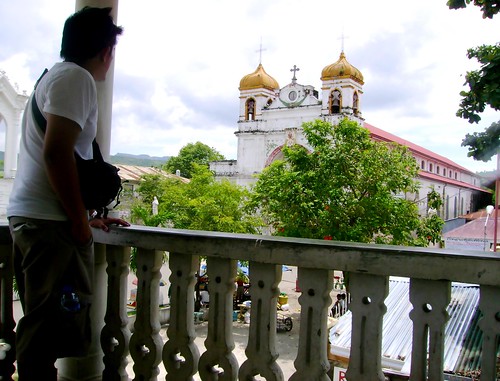 [/caption]
[/caption]They call it south station, a place where you’ll find buses, mini and full size or jumbo jeeps all en route to the southern part of the province. I was headed to one of the most beautiful town in southern Cebu, Carcar. I was visiting the town for the first time, could be the only time, but I was certain that this would be a unique trip. Travel time is about two hours, or more, but on the road I seem to have lost track of time, thanks to the many sights of peculiarity (like a two wheeled motorcycle carrying four adults and a child!) and beauty of along the way.
Somewhere in Naga one could catch a view of the sea from the road; it was quite a sight, the strong sea breeze and that bizarre smell of the sea is so strange for a stranger Manileno. The major roads here are all built alongside the coastline, as you go farther south you see less of the metropolitan we are all use to seeing. I was starting to see the true rural Cebu (bahay kubo’s in the truest meaning of the name), towns squash in between the sea and the hills. One could not say that they have been in Cebu the provincia, if they’ve never visited this bucolic situates.
Carcar sits together with Taal and Vigan as the only NHI declared heritage towns in the country, they have maintained their town inside a time capsule but just imagine if most of the old towns in all of our islands were preserved, they all could be drawing tourist cash, livelihood in short for the towns people, lack of foresight by both leaders and people in most town has deprived them of such opportunities.
Like Binan for example, a rich Laguna town that has lost allits heritage structures – what was once a model of progress and fine living is no more, the Alberto house is now the only remnant of Binan’s celebrated past, but this residence is also imperil and would soon be gone – just like everything else in Binan.
The past decades has seen a rapid increase of old Hispanic houses being brought down, if not by men, by forces of nature due to years of neglect – San Nicolas in Manila is a fine example of this, I was surprised to know that Manila does not even have an incentive plan for those who would try to keep their old homes intact – no wonder owners would rather bring an old house down than preserve it due to expense, an old home would cost more, double to maintain than a new one – when sold it would always fetch a high price in the realty market, here in Carcar, the people need not look for the government to compensate them, there’s pride among these people, they’re enormously proud of their town and history, and most are willing to tour people around their town. There are many lessons we can learn from these Carcaranon’s, Manila can find answers here in heritage preservation thats if we can go past politics and incompetency.
[caption id="" align="alignnone" width="375" caption="Fascade of the Sta. Catalina"]
 [/caption]
[/caption]It’s only fitting that Carcar has been recently declared a heritage town. Everywhere you go you’ll find traces of what life was like during the glory days of one of the richest, historically and culturally, town in Sugbuanon history. The houses were built using the finest materials– the elite was showing off here, they live life in grand style; little did they know that they were building more than splendid homes but monuments of beauty.
The original town was built on top of barrio Valladolid but was later relocated to its present location because of the brutal Moro raids; Valladolid was vulnerable because of its proximity to the sea. It is said that Carcar’s church has been rebuilt many times, the pueblo’s present house of prayer was established in 1860 by Fray Antonio Manglamo, supplementary works to improve what was started by Fray Manglamo was done by Fray Gonzalez and later by a certain Fray Rubio. These men of clothe would later develop roads that would connect the calles’ straight to the gates of the parish.
There are impressive descriptions of this church from more established writers, but one thing that everyone seems to reiterate is that the church appears to be deeply influenced by Moorish design; at first glance it appears to be somewhat of a small Middle Eastern mosque than a Catholic church. It has maintained its appearance for more than a century is a tribute to the Carcaranon appreciation of safeguarding these treasures. This generation could only hypothesize why it was designed that way, but there’s beauty in mystery.
But still, I could not understand how a town, who was frequently assaulted by the atrocious Moro raiders’, snatching town people making them slaves and stealing treasure could appreciate Islamic inspired architecture.
[caption id="" align="alignnone" width="375" caption="The interior of San Catalina"]
 [/caption]
[/caption][caption id="" align="alignnone" width="381" caption="The choir loft inside the church"]
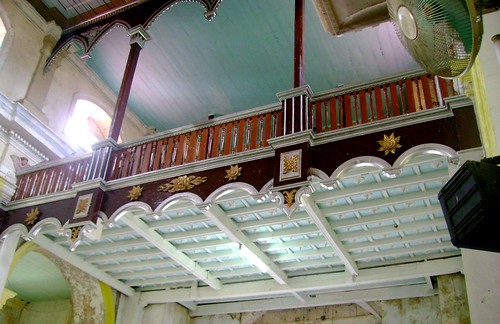 [/caption]
[/caption]The twelve stone apostles’ in Sta. Catalina watches over its surrounding and just like in the scripture – Judas is isolated in an obscure spot while the rest stands proud around the church walls. Figures of Cherubim’s and statue of uniformed Angels are on every corner inside the church – they’re everywhere actually, and its more than an assurance that you are indeed in a divine place.
[caption id="" align="alignnone" width="375" caption="Giant foundations found inside the church"]
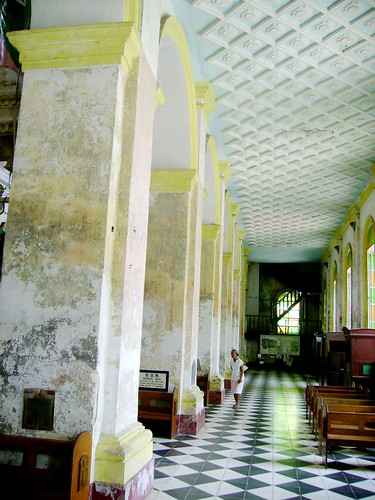 [/caption]
[/caption][caption id="" align="alignnone" width="380" caption="Nuestro Biloy! (Our Biloy!) Beautiful markers dedicated to active church members"]
 [/caption]
[/caption]Prominent lapidas’ exposing the prominent members of the town, men who donated to the construction of the church usually are honored by these death plaques, names’ that are recognizable because most belongs to the elite families of Carcars.
The town is memorable at least to revolution historians because it was here that the uprising was dealt a major blow in its southern theater, the death of Leon Kilat – not in the hands of the Espanoles but by fellow Filipino’s who were not in good terms with the Katipunan’s plans.
In the arts, Martino Abellena is the biggest name. Abellana, this province greatest painter has almost single handedly resurrected the art of painting in the province. Romulo Galicano studied under Abellana.
[caption id="" align="alignnone" width="375" caption="The Puericulture during the American colonial now known as the Carcar Museum"]
 [/caption]
[/caption][caption id="" align="alignnone" width="375" caption="The receiving platform of what was once the towns Puericulture"]
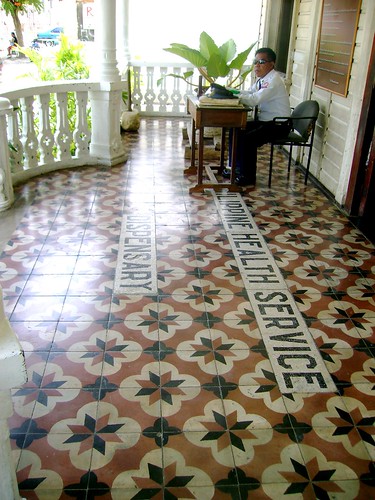 [/caption]
[/caption]The puericulture which has been transformed into a museum is a beautiful monument of the American era, if there is one thing that we could really be grateful for with the Gringo’s is that they brought cure to the disease’s of 19th century Philippines, the cholera for example was ended in Manila and in the countryside, there was these successful medical system – the Puericulture is a clinic for the women and child, and this one in Carcar is not just another standard clinic but the manner of its construction just only shows, again that Carcaranon’s built differently, when you get to see Carcar, you’ll understand what I mean. They still refer to their day care centres here as Puericulture.
[caption id="" align="alignnone" width="375" caption="A colorful colonial house"]
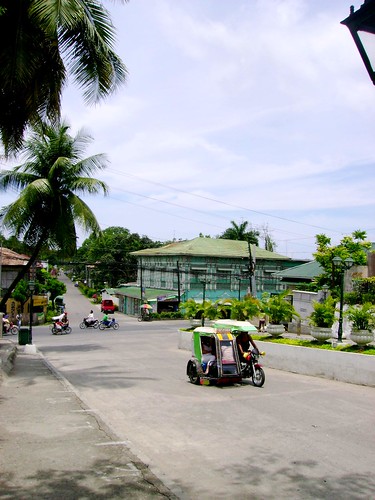 [/caption]
[/caption]In this town one could also find the original rail track built by the Spaniards, during its peak, it traveled south to north, transporting goods and people, too bad that it was not resurrected after it was abandoned, it yielded to neglect and lack of vision and is now just a relic of the bygone days. The Cebuano generation does not even know that such railroad system exist!
[caption id="" align="alignnone" width="422" caption="Old home converted into pretty little shops"]
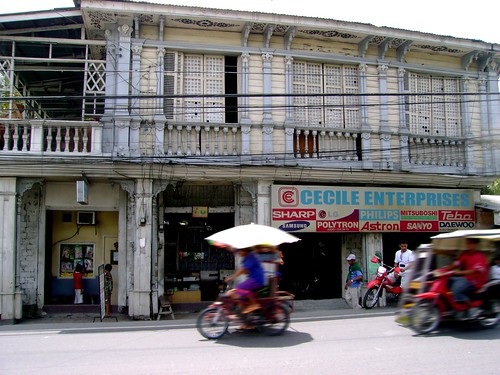 [/caption]
[/caption][caption id="" align="alignnone" width="428" caption="A common "bahay na Bato" around Carcar"]
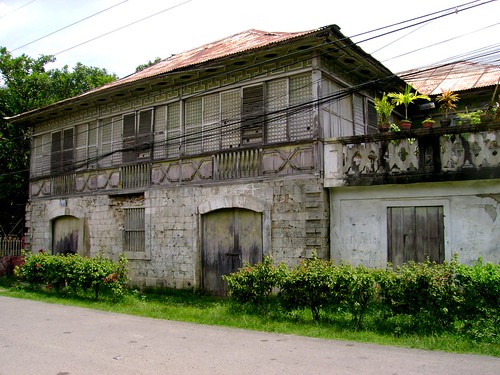 [/caption]
[/caption]Heritage homes of the great families of Carcar are everywhere, ruins can also be found. What’s surprising is that even those homes in dire condition, are still somewhat intact. Calles are clean and everything seem to be in order here.
I can go on and on and talk about what this town can offer but this is one of those places that one must see to better appreciate, being around Carcar reminded meof how deeply rooted our culture is to our religion and Hispanic past.



Brotha, there's Jollibee just recently put up at Alberto house's silong. Binan's beginning to look more like Divisoria these days hehehe.
ReplyDeleteHope I can visit Cebu this year so we can follow your trail.
ReplyDelete¡Bahay na bató! My dream house! Bring it on! I want some more!
ReplyDeleteFriends - just inform me if any of you plan to visit Cebu, it would be an honor to tour you guys.
ReplyDeleteWow brotha! Joan's asking if you'll sponsor the trip too hehehe. Just kidding.
ReplyDelete"Brotha, there’s Jollibee just recently put up at Alberto house’s silong. Binan’s beginning to look more like Divisoria these days hehehe." -- Levi.
ReplyDeleteThat's sad, Boss Levi. I'm aghast that even the municipal government of Biñán, Rizal's "other" hometown, shows how ignorant and pathetic they can be with regard to historical conservation.
I'm a Jollibee supporter because I'm a Filipino(although McDonald's food are far more tastier). But for that sad news you just imparted to us, there's no more reason for us to BEE HAPPY.
Oh yes I agree Pepe. It's just too frustrating to see this Municipality letting it happen when the structure's just a stone throw away from the Municipio.
ReplyDeleteYou know, we can ETA that jologbee to smoke. The municipal bigwigs won't listen to us since to them, that's a cashcow. Oh, perhaps we can off some of them as well.
ReplyDeleteAnd Pepe, just because you're Filipino doesn't mean you have to automatically support local goods and services. Unbridled flag-waving nationalism can be just as horrible as colonial mentality.
Actually, Jollibee is owned by a Chinese.
ReplyDeleteEuskadi Ta Askatasuna is always like that ever since I refused to publish his terroristic comments in my website. Hahaha!
ReplyDeleteso they've already returned the angels at their (new) pedestals. i must visit this again to post an update within the week :)
ReplyDelete